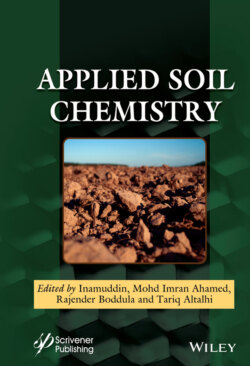Читать книгу Applied Soil Chemistry - Группа авторов - Страница 20
1.2.1 Weather Conditions and Fluctuations
ОглавлениеPrevailing weather conditions substantially influence the quantity of carbon present in soils. This is not simply due to differences in specific climatic zones and geographical environments that clearly plays a substantial role. It is well established that the carbon content of soils reduces from the equator to the poles, mainly as a consequence of climatic variations [23]. Specifically, it is biophysical variables such as humidity and temperature conditions in a soil that determine the rates of microbial and bacterial metabolism. Up to a point higher temperatures and humidity tend to increase metabolic rates; whereas, water-saturated soils, starved of oxygen result in a decrease in metabolic rates. It is the latter conditions that are responsible for massive deposits of peat, formed in cooler and wetter regions and tropical regions, resulting in massive carbon sinks developed over millennia. In many environments, soil water content is the dominant factor in determining the quantity of carbon preserved in peats. In cool or warm arid environments, the lack of soil moisture tends to inhibit the degradation of organic matter but carbon input tends to be low in such soils, leading to their low NPP.
Of course, fluctuating weather conditions also influence soil erosion rates in specific areas. Even if soil temperature and humidity are well balanced to fix large quantities of carbon, that is not much use as carbon sequestration sink if large quantities of the soils produced are frequently eroded by deluges or floods related to periodic or seasonal extreme weather events.
As soils tend to hold less carbon at higher temperatures, Sun et al. (2019) [22] considered the potential release of carbon to the atmosphere from forest soils based on a range of global warming scenarios. They estimated that by the end of this century, the top 20 cm of forest soils globally would release some 6.58 Pg C to the atmosphere if there was just a 1°C increase in global mean air temperature. On the other hand, they suggested that those soils could release as much as 26.3 Pg C to the atmosphere if there was a 4°C increase in global mean air temperature. In either case, the addition of carbon to the atmosphere would likely exceed carbon uptake from reforestation and forest growth.
Rate of decomposition and availability of carbon in soil to microorganisms is often used to distinguish two type of organic carbon in soil: labile and recalcitrant [24]. Labile soil carbon tends to be associated with microbial biomass, dissolved organic matter that is easily oxidized and broken down. Recalcitrant organic carbon in the soil are compound that are resistant to microbial decomposition. Recalcitrant organic carbon tends to be associated with soil mineral particles. Zhang and Zhou (2018) [25] estimate that more than 80% of mineralized soil carbon is derived from the recalcitrant pool of soil organic matter in the temperate forests of northern China. In those forests, the quantity of mineralized soil organic carbon slightly increased with soil moisture content. Mineralization of soil carbon clearly plays a key role in the carbon cycle in terms of determining soil’s ability to store quantities of carbon in a stable manner over long periods of time. That ability is strongly influenced by temperature and moisture content.
